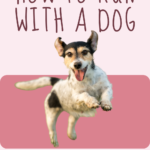Support for the blog comes from using the affiliate links below. At no additional cost to you, I may earn a commission on purchases. Thank you in advance.
Positives of running with dogs
Running outside is great for your heart health, mental health and overall wellbeing. The fresh air in your lungs and sun on your neck beats running on a treadmill any day. The added bonus of running outside is you can take your pup along with you! By combining your exercise with theirs, you free up extra time in your day to focus on other things. I also love running with my dog because each time I look down at him he always has a content smile on his face which brings me so much pleasure to see. I know he loves to stretch his legs and get in a good run and I love being able to provide that for him.
How to run with your dog
Doggy distance
The distance of your run will depend on the breed of your dog. A naturally active, high-energy dog is great to go running with as it can cover lots of ground and has lots of energy to burn. Smaller dogs with shorter legs such as Corgis, Dachshunds or Terriers can still enjoy a run with their owners but may prefer shorter distances of about 2-3 miles. Similarly, extra-large dogs such as Great Danes should also generally stick to shorter runs. Finally, Brachycephalic dogs, those with short muzzles such as French Bulldogs and Pugs are not ideal candidates for running as they may have difficulty breathing with intense exercise.
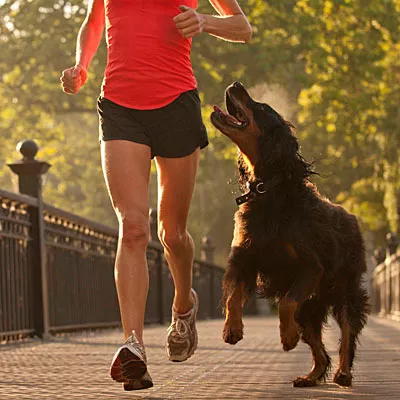
Puppy power
If you have a puppy it is recommended to wait until the growth plates (areas of cartilage near the ends of bones) have completed development as running on hard surfaces can damage a puppy’s joints and bones that haven’t fully formed yet. It is best to check with a vet to confirm this has happened as the time frame for this varies by breed and size of dog. A larger dog will take a longer amount of time for the growth plates to seal up.
Expert advice
If you aren’t sure whether your dog will be a good running partner, it’s good to check with your veterinarian before you start. They will be able to check your dog’s overall health and determine if there is anything present which would prevent your dog from running such as arthritis, obesity, age or hip dysplasia.
Don’t run before they can walk
It is important that your dog can walk to heel on a leash before you begin to run together. Running with a dog that pulls is not fun and can result in injury for both of you. Ensuring they have good recall is also necessary for off-leash runs. Another good command for them to learn is “leave it” which stops them from being distracted by other things such as wildlife or dropped food.
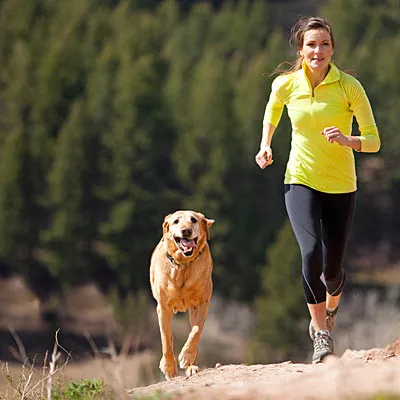
Bring the right gear
There are dog leashes specifically designed for running that include an elasticated leash clipped to a belt with different attachments. This allows for your hands and arms to move freely as you run and not be restricted by holding a dog leash. I also like to run with a Camelback which allows me to hold my water, phone, keys, dog bowl and poop bags all in one place whilst I run.
Start slow
Sedentary people can’t jump off a couch one day to run 10k and neither can dogs. It is important to start out slow as too much too soon increases your dog’s risk of injury. Increase the speed and distance over the course of several weeks.
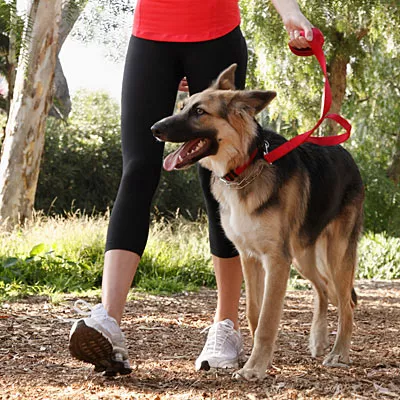
Start with a warm-up
Give yourself and your dog a few minutes of walking before you pick up the pace and begin running. This will allow them to warm up their muscles and the chance to sniff around and do their business. If they don’t poop during the warm-up then be cognisant of their need to stop during the run to relieve themselves.
Bring water for your pup
Dogs can’t tell us when they need a water break so it’s good to stop every 10 minutes when you are first starting out for a water break before you get an idea of how much water they’ll need on a run. You’ll want to carry a container that your dog can drink from, like a collapsible bowl or a bottle with a special spout for dogs.

Avoid running when it’s too hot
It’s important to remember that dogs don’t sweat through their skin and instead pant as a means to bring their body temperature down. Pushing them too hard in the heat can lead to hyperventilation and breathing difficulties. Avoid running in the midday sun and where possible, run in the shade. Let your dog stop when they want, and don’t try to push them further. Also, place your hand on the surface you are running on to check the temperature. If you can’t hold your hand there for more than 10 seconds then it is too hot for your dog’s paws and should be avoided.
Check their paws
When you arrive home check your dog’s paws to make sure they haven’t suffered any cuts or injuries whilst out. If you run in the heat, check they don’t have any burns and if you run in the snow, try to avoid roads that have been treated with salt, which can sting dogs’ feet—and then upset their stomachs if they lick their paws once they’re inside. If you live in an area with extreme temperatures during the year then consider choosing a dog treadmill for when outside runs are not possible.
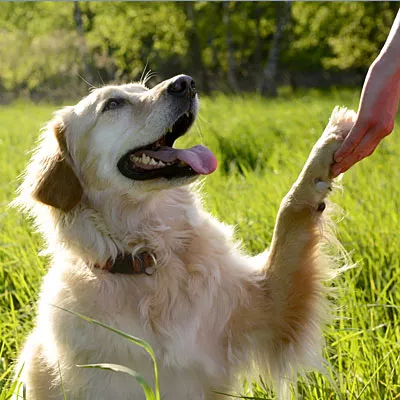
I hope this guide helps you as you start out on your running journey with your pup. You two are now a team and exercising together is only going to strengthen your bond.
Conclusion
Running with your dog is a great way to bond and get some exercise together. Just remember to take things slowly, bring the right gear and check your dog’s overall health before you start running. Additionally, it is important to remember to provide frequent water breaks, check their paws after runs and avoid running in extreme temperatures. Following these tips will ensure you and your pup have an enjoyable and safe running experience.


